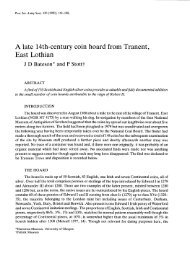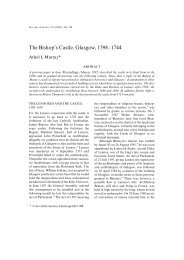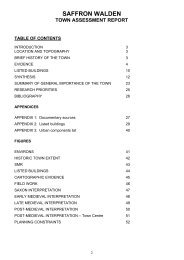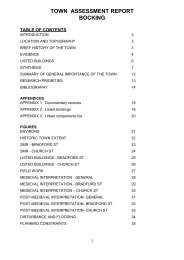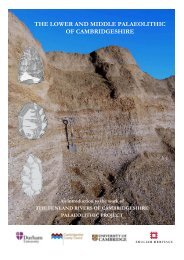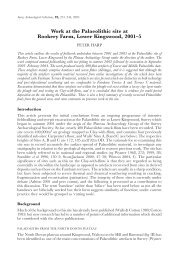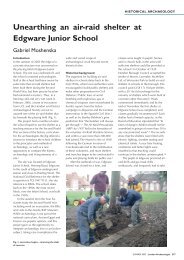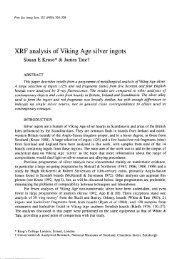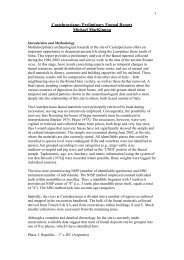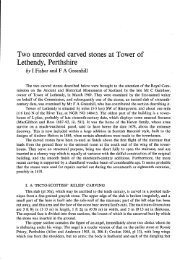The late Iron Age and Roman settlement at Leda Cottages, Westwell ...
The late Iron Age and Roman settlement at Leda Cottages, Westwell ...
The late Iron Age and Roman settlement at Leda Cottages, Westwell ...
You also want an ePaper? Increase the reach of your titles
YUMPU automatically turns print PDFs into web optimized ePapers that Google loves.
CTRL Integr<strong>at</strong>ed Site Report Series <strong>Leda</strong> <strong>Cottages</strong>, <strong>Westwell</strong><br />
suggest th<strong>at</strong> this was the case. It is possible th<strong>at</strong> the enclosure was not bounded to the south by<br />
a ditch but by a n<strong>at</strong>ural fe<strong>at</strong>ure such as a wood. <strong>The</strong> ancient woodl<strong>and</strong> of Leacon Wood,<br />
Charing, is situ<strong>at</strong>ed only c 250 m north-east of the site, although, as it is often the case with<br />
such l<strong>and</strong>scape fe<strong>at</strong>ures, it is extremely difficult to demonstr<strong>at</strong>e its antiquity. Its identific<strong>at</strong>ion<br />
as a historic woodl<strong>and</strong> is based on its appearance on the first edition 1'' OS map, d<strong>at</strong>ing from<br />
1819 (URL 1994).<br />
Metalworking activities<br />
Evidence of ironworking activities was recorded on the site, in the shape of one smelting<br />
furnace situ<strong>at</strong>ed within the <strong>l<strong>at</strong>e</strong> <strong>Iron</strong> <strong>Age</strong> enclosure <strong>and</strong> a cluster of seven fe<strong>at</strong>ures, loc<strong>at</strong>ed 100<br />
m north-west of the main site, down the slope. This activity is likely to have started during<br />
this phase, but the d<strong>at</strong>ing evidence is very slight <strong>and</strong> the phasing of the relevant fe<strong>at</strong>ures is<br />
r<strong>at</strong>her tent<strong>at</strong>ive.<br />
Furnace 8300 (Fig. 5), just inside the east side of the enclosure was roughly oval with a<br />
moder<strong>at</strong>ely sloping side to the north, a steeper southern side <strong>and</strong> a fl<strong>at</strong> base, measuring 1.1 x<br />
1.4 m, with a depth of 0.27 m. <strong>The</strong> discoloured surrounding earth showed evidence of being<br />
subjected to high temper<strong>at</strong>ures <strong>and</strong> many fragments of slag <strong>and</strong> burnt clay were visible on the<br />
surface. This iron smelting furnace did not produce any d<strong>at</strong>ing evidence but was likely to have<br />
been contemporary with the enclosure on the basis of its sp<strong>at</strong>ial rel<strong>at</strong>ionship with ditch 8624.<br />
<strong>The</strong> main cluster of ironworking fe<strong>at</strong>ures (Fig. 6) was composed of four smelting<br />
furnaces (8009, 8648, 8649 <strong>and</strong> 8650), two pits (8007 <strong>and</strong> 8019) <strong>and</strong> a thin spread of charcoal<br />
(8030). Circular furnace pit 8009 had concave sides <strong>and</strong> base, a diameter of 0.35 m <strong>and</strong> was<br />
0.35 m deep. It contained 2 non-abraded pottery sherds (20 g) d<strong>at</strong>ed to 50 BC-AD 70. Furnace<br />
8650 had a similar profile, a diameter of 0.50 m <strong>and</strong> a depth of 0.13 m. Furnace 8648 had a<br />
circular pit with a steep profile on the eastern side, moder<strong>at</strong>e on the western side <strong>and</strong> a<br />
concave base, surrounded on its western edge by an area of burnt earth. Its diameter was 1.3<br />
m <strong>and</strong> its depth was 0.35 m. Furnace 8649 was similar in profile, steeply sloping to the northwest<br />
<strong>and</strong> moder<strong>at</strong>ely sloping to the south-east, with a concave base, a diameter of 2.10 m <strong>and</strong><br />
a depth of 0.40 m. One phase of re-cut was recorded within furnace 8649 <strong>and</strong> it was<br />
subsequently trunc<strong>at</strong>ed by the <strong>l<strong>at</strong>e</strong>r furnace 8651, which contained 3 small sherds (8 g) of<br />
pottery d<strong>at</strong>ed to AD 175-270. It is therefore likely th<strong>at</strong> furnace 8649 was in use prior to AD<br />
175.<br />
Pit 8007 was sub-circular with vertical sides <strong>and</strong> a fl<strong>at</strong> base, measuring 0.80 by 0.72 m<br />
<strong>and</strong> 0.16 m deep. No evidence of in situ burning was visible in the ground <strong>and</strong> its single fill, a<br />
dump deposit of smelting debris, suggests th<strong>at</strong> it may have been a rubbish pit. Pit 8019 was an<br />
elong<strong>at</strong>ed, irregular shaped fe<strong>at</strong>ure with steep sides <strong>and</strong> a fl<strong>at</strong> base with in situ burning,<br />
measuring 4.40 by 2.70 m, with a depth of 0.22 m. Traditional methods for making charcoal<br />
7






